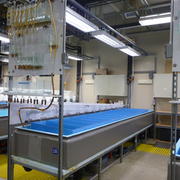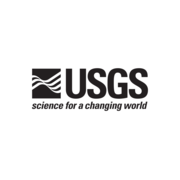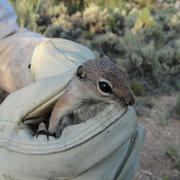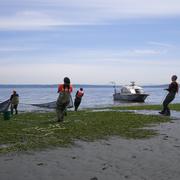Ecosystems
Data and Tools
Effects of early life stage exposure of largemouth bass to atrazine or a model estrogen (17α-ethinylestradiol)
Largemouth base histological development and transcriptomic changes in gonad tissue after early life stage exposure to Atrazine (1-Chloro-3-ethylamino-5-isopropylamino-2,4,6-triazine) or the model estrogen 17α-ethinylestradiol.
Immunological histopathology of American kestrels (Falco sparverius) exposed in ovo to two persistent organic pollutants -- SCCPs and TBBPA-BDBPE
This work is part of a study of the immunological effects of exposure to alternative flame retardants in avian species. For the pathology portion of the study, spleens and bursas from American kestrels (Falco sparverius) exposed by egg injection to varying doses of short-chain chlorinated paraffins (SCCPs) and the flame retardant TBBPA-BDBPE were examined microscopically for architectur
Immunological histopathology of American kestrels (Falco sparverius) exposed to the flame retardant isopropyl triphenyl phosphate
This work is part of a study of the immunological effects of exposure to alternative flame retardants in avian species. For the pathology portion of the study, hatchling American kestrels (Falco sparverius) were exposed to the flame retardant isopropyl triphenyl phosphate (ITP) and then challenged with a synthetic analogue of viral double-stranded RNA, polyinosinic:polycytidylic aci
Necropsy reference number and summary collection information for Washington state population of northern sea otters examined during 1989-2010
Morbillivirus epidemics in marine mammals first gained prominence in 1988 when an outbreak of phocine distemper virus (PDV) occurred in European harbor seals (Phoca vitulina vitulina). Prior to 2001, all serosurveys for morbilliviruses in sea otters (Enhydra lutris) in California, Washington and Alaska documented a 0% seroprevalence. The first published serodetections of morbi
Fleas collected from black-tailed prairie dog burrows in 2016 and 2017
The data are a list of the number and species of fleas that were collected from black-tailed prairie dog burrows in Montana, North Dakota, South Dakota, Colorado, and New Mexico. Fleas were collected by swabbing ~100 burrows at 3 sites at each of 6 sites. Burrows were sampled twice each summer during 2016 and 2017.
Histopathology of bearded dragons (Pogona vitticeps) exposed to Nannizziopsis guarroi
This work is part of a study demonstrating that the fungus Nannizziopsis guarroi is the cause of the disease known as yellow fungus disease in bearded dragons (Pogona vitticeps) by fulfilling Koch’s postulates. In this study, bearded dragons were exposed to N. guarroi to assess gross and microscopic lesion development and the ability to re-culture the fungus from infected sites. At
Southwestern Willow Flycatcher Habitat Viewer
The Flycatcher Habitat Viewer was developed to meet the needs of organizations by providing maps of predicted flycatcher breeding habitat throughout its range. Maps are provided from 2013 to present and cover 57 satellite scenes. Maps identify predicted flycatcher habitat based upon the amount of green vegetation within a 120-m radius of each cell, and the size of floodplain within a 360-m...
Chemical and biological data from acute and chronic nickel and zinc exposure bioassays to two sensitive freshwater benthic invertebrates
The responses (survival, growth, and/or reproduction) of test organisms in six concentrations of toxicants in acute and chronic tests. Chemical and water quality parameters were measured for quality assurance and quality control purposes.
Chemical analyses and histopathology of organisms and plants collected from breccia pipe uranium mine sites in the Grand Canyon watershed, 2015-2020
These data are comprised of measurements of aluminum, iron, cobalt, nickel, copper, zinc, arsenic, selenium, molybdenum, silver, cadmium, thallium, lead, bismuth, thorium, uranium, and mercury in invertebrates, vegetation, and small rodents. Gross alpha activity, gross beta activity, and radionuclide activities (isotopic U, isotopic Th) are also pres
Data collected in 2010 to evaluate habitat availability for surf smelt and eelgrass in response to sea level rise on Bainbridge Island, Puget Sound, Washington, USA
This dataset includes biological variables showing surf smelt spawning presence, geological variables describing beach composition, and sample locations using RTK-GPS. This field data was also used to run the Sea Level Affecting Marshes Model (SLAMM; Warren Pinnacle Consulting, Inc., Warren, Vt)) to predict the changes to beaches over time, and under different sea level rise
Nuclear inclusion X testing of Pacific Razor clams from select locations in Washington and Alaska
A quantitative PCR (qPCR) assay was developed to detect nuclear inclusion X (NIX) in Pacific razor clams, and assay specificity was confirmed by chromogenic in situ hybridization (CISH). Both tests were applied to evaluate NIX infections in wild Pacific razor clams collected during spring 2019. Consistent with results from earlier histopathological assessments, qPCR and CISH indic
Plague causes fragmentation of prairie dog colonies in Conata Basin, South Dakota from 1993 – 2015
This data was used to investigate the invasion of a non-native disease, plague, to a keystone species, prairie dogs, in Conata Basin, South Dakota, United States. We documented the resulting extent of fragmentation and habitat loss in western grasslands using colony boundaries mapped by the USFS every one to three years from 1993 - 2015. Specifically, we assessed how the arrival of







